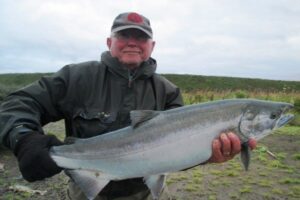
Alaska Peninsula Silver Salmon
COHO NIRVANA ON THE ALASKA PENINSULA
For a die-hard anadromous salmonid angler, the endless conga line of chrome-sided silver salmon pouring upriver past me as I stood knee deep in the current was a truly astonishing, awe-inspiring sight.
Targeting a group of twenty-plus coho that were approaching in the clear shallow water, I cast towards the lead fish. I swung my concoction of bright feathers and shiny tinsel on a tight line across the current, adding false strips so as to impart a tantalizing action to my offering. A pod of five salmon immediately turned and gave chase, and a stout 13-pound hook-nosed buck beat his companions, creating a huge surface boil as he savagely clamped his jaws onto the bright pink fly. I swept my Spey rod in a low arc towards the near bank to set the hook – and he responded by immediately blasting across and down the river, followed by yards of backing that rapidly disappeared from the screaming Hardy reel.
I tried to palm the rim of the big Duchess to slow the vanishing coho, but jerked my hand away as the friction from the click drag caused the reel to become too hot to touch. The faint odor of burning lubricant wafted towards my nose, and the whirring handle was rapping my knuckles, rat-a-tat sound accompanying the howl from the reel’s double click pawls.
The fish finally stopped far below me, and he wallowed and violently shook his head as I tried to hold him in the swift current, with my long Winston rod throbbing and taut line humming like a guitar string in the heavy flow. Our détente lasted only a few seconds as the big buck then decided that his best chance to escape his tormentor was to continue back to vast expanse of the Bering Sea. Once again the Hardy sounded out in protest, and the rattling howl combined with sound of whacking bones resumed, as I began to wonder if I could ever land this out-of-control, crazed salmon…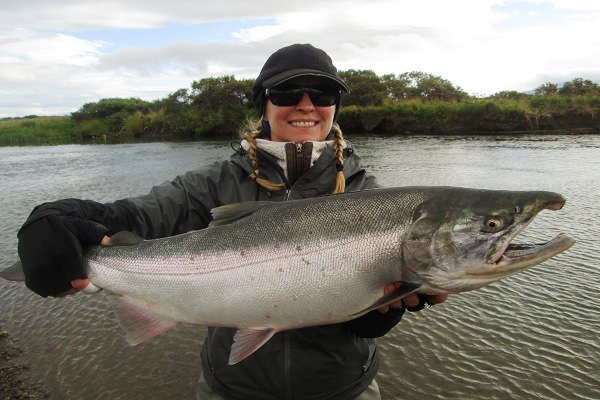
I struggled towards the shore and stumbled through the shallows along the gravel bar towards the vanishing coho, but found myself suddenly confronted by a steep drop-off with water beyond that was too deep to wade through. As I was evaluating my remaining options, the fish suddenly veered towards an enormous jam of downed trees in an instinctive bid for freedom. Foregoing caution, I performed a Spey harkari, bending my rod all the way to the cork grip, free hand wrapped around the Duchess in a desperate attempt at preventing the buck from ensnaring himself in the underwater branches. The maximum pressure finally succeeded in stopping the fish only a few feet from the submerged tangle; for long seconds, neither of us gave any quarter, as the uncertain outcome of our battle hung in the afternoon sunlight that shimmered the river’s surface.
Finally, the buck began to weaken, and I switched to a low, sideways rod angle that added a bit of slack line. I ceased my pulling, and I was vastly relieved when the fish responded by slowly swimming towards me and away from the hazards. Nearly 200 yards and a swift current separated me from my prize, and so I put the tip of the rod underwater, pointed it at the fish, and commenced to steadily reel the big Hardy. By keeping all of the line in the water, it bellied below the fish, which then induced him to swim opposite to the direction of pressure i.e. upstream against the current. This technique – affectionately known as “Walking the Dog”, and shown to me by my guide and good friend Trevor – can be very effective for landing fish that have run far downstream, in situations when you’re unable to give chase…
Following a series of yet more cross-stream dashes that took back much of the line that I had so painstakingly won, the coho salmon was finally slid into the shallows, a chrome torpedo wallowing at my feet as he surrendered to the boron, graphite, and nylon. I marveled at his enormous blimp-like girth, his broad broom-shaped tail, and the quivering muscles that were humped well above and behind his gator-sized head. A coterie of parasitic sea lice copepods hung down near the ventral fin, their dark color and long tails indicating that this salmon had been in the river for mere hours – hence the sheer strength and amazing stamina displayed in his bid for freedom. Using care to avoid sharp teeth that would be subsequently used in spawning ground battles with rivals, I removed the barbless stinger hook, and held him upright facing into the current. Strength returning, he bid adieu with a sweeping splash to resume his final sojourn.
It was the first week of September on the remote Alaska Peninsula, and our group of avid coho salmon anglers had reunited to pursue anadromous chrome at one of the very best remaining spots on the planet to encounter vast numbers of Oncorhynchus kisutch that could be caught with Spey tackle and swinging flies.
This was my seventh trip to the Sapsuk River and to APICDA’s riverside camp, located just west of the Aleut village of Nelson Lagoon. We had traveled aboard an ultra-modern, Swiss-built Pilatus aircraft (chartered from Alaska Air Transit) and our 500-odd mile flight from Merrill Field in Anchorage had taken us over snow-capped volcanoes that soared into the skies along the west side of Cook Inlet and formed the backbone of the narrow Peninsula. Vast stretches of rolling tundra, pocked with countless ponds and crisscrossed by waterways both large and small, appeared below us, mixed with occasional glimpses of lonely beaches upon which the Bering Sea expended its fury during fierce storms.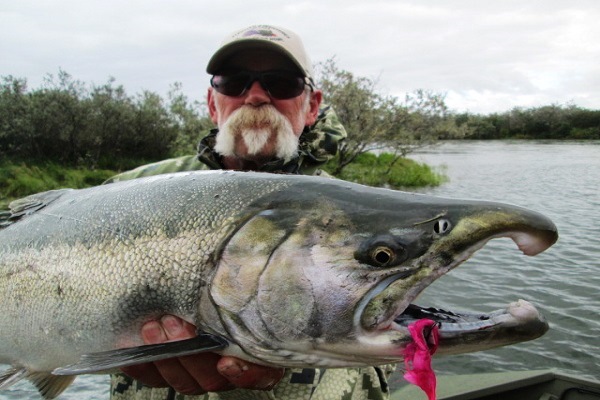
Landing on the gravel airstrip in Nelson Lagoon, our expert pilot – a former Navy flier who had made hundreds of landings aboard an aircraft carrier – touched done softly. Clouds of dust billowed behind us, as we taxied towards the greeting crew. Waiting for us were wonderful folks Merle, Sharon, and Kenny, who were lifelong residents of this tiny Alaska Native community. Our gear was quickly offloaded, and as the previous week’s anglers boarded the plane for their return back to Anchorage, they confirmed that the main run of coho salmon had indeed arrived in the river.
We enjoyed the comfort of Sharon and Kenny’s house, and were treated to their wonderful hospitality and a delicious steak dinner as we waited for the rising tide. The sun began to drop towards the horizon when peak flood filled the Lagoon, and Merle piloted the big aluminum vessel across the wind-driven chop towards the mouth of the Sapsuk, where we were met by the smaller jet-powered sleds brought downriver by the guides. I waved as I saw my dear friends Mike and Trevor approach us, and rounds of fist bumps and hugs followed our reunion with the awesome camp staff. We piled luggage, rod cases, and mounds of provisions into the boats, then fired up the Yamaha outboards for the last leg up to camp, arriving at dusk to be greeted by our delightful cook Kathy.
After hastily stowing my gear in our assigned WeatherPort tent, I hurried down to the river to make a few casts in the remaining light. My first throw resulted in a bright 9-pound hen that somersaulted repeatedly across the water, with the 7- weight Winston BIII 13’3” Spey rod bucking and 4” Hardy Bougle reel howling in response. I managed to hook four and land three more cohos before the descending darkness reminded me to yield the river to the nocturnal bruins (whose large paw prints marked their passage on the very same trails that we anglers use). Back at camp, I re-secured the protective electric fence, and took a hot shower before turning in.
Early the next morning, my alarm rang just before the camp generator fired up. Grogginess dispelled via another shower, I sat down with Diana, Jerry, Mike, Mark, Kirk, and Charlie to a delicious and hearty breakfast in the warm dining tent. This trip, I had vowed to change my reputation as being the last person who showed up down at the boats (!), and I thus hurriedly finalized my gear preparation post-repast, rigging two more Winston Spey rods, and stowing additional tackle items inside my waterproof Orvis sling pack.
Mike and Trevor were waiting for us at the boat landing, and we cast off at first light. Due to a series of early fall rains, the water levels were higher this year, and both guides opted to take us upriver where the silver salmon were more concentrated. We motored past typically productive spots such as the Mojo and Cabin runs, with the other group of Mike C, Mark, Diana, and Jerry (guided by Mike F) electing to stop at the Weir Pool; our guide Trevor decided to start Charlie, Kirk, and I further above.
Through polarized sunglasses, we were delighted to see hundreds of bright cohos holding at every deep run upstream of camp. It took only 10 minutes to reach our first fishing spot, and our initial casts resulted in hookups with chromers that leapt high above the water, bending our rods and yanking line against tight drags. Excited whooping, broad grins, and gleeful high-fives ensued between all of us – how wonderful it was to be back in Coho Nirvana!
Coho salmon (Oncorhynchus kisutch) — also known as silvers — are eagerly sought after by Alaska fishers because of their widespread distribution and vigorous fighting abilities (which includes amazing leaps and powerful runs). Marine anglers catch thousands of cohos in the ocean and estuaries during the summer months, while others target them in freshwater, as they ascend rivers to spawn during autumn.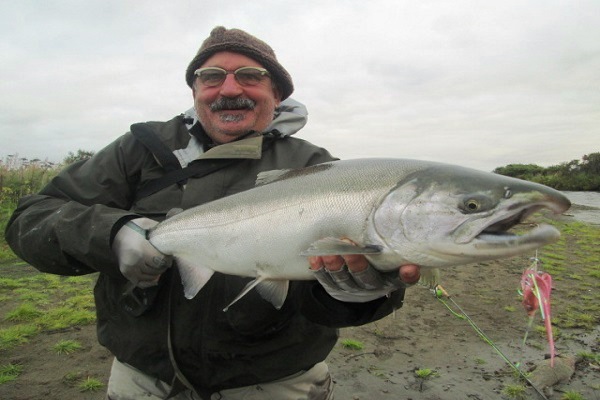
The Alaska Peninsula’s silver salmon runs occur later than most others, and these fish have additional weeks of ocean feeding before commencing their final journey. Thus, compared to other systems with earlier runs, the average size of the adult cohos caught here can be considerably larger – many fish are over 10 pounds, and our Sapsuk guide Mike weighs silvers that exceed 16 pounds every season.
As anyone who has fished for freshwater cohos can tell you, these fish can become dour once the initial action on eager fish is concluded – leaving anglers frustrated while watching dozens of unwilling salmon mill about, ignoring all offerings. However, the sheer numbers of silvers spread out over many miles of river on the Sapsuk – and lack of competition, as there are only two operators here — means that you merely move to the next un-fished spot to find fresh biters and resume the hot angling (!).
Having sampled waters throughout Alaska that range from heavily-frequented to remote/lightly fished, the coho angling success on the Sapsuk exceeds anywhere else that I’ve visited. Coupled with the opportunity to cast light tackle in a moderate-sized river, along with minimal angling pressure, and over hundreds of fresh, out-sized silvers that arrive each day, the Sapsuk offers an unparalleled opportunity for both seasoned swing fishing experts and novices to satiate desires of hooking sea-run chrome salmonids, until you’re completely exhausted…
Just how good is the coho angling on the Sapsuk River? Here are my tallies from the two most recent years:
- 2016
- First trip: 646 cohos hooked during 6 days, 383 landed on Spey gear/swinging flies (including a day with 112 fish landed)
- Second trip: 355 cohos landed on Spey gear/swinging flies during 4 days (including a day with 89 fish landed); there was 1 day of high and muddy water plus another one that we spent searching for steelhead in the upper reaches
- 2017: 417 cohos hooked during 5 days, with at least 267 landed (including a day with 108 hooked and 86 landed on Spey gear/swinging flies)
*Note: APICDA’s camp is located in the heart of the best water, and each day’s angling begins within minutes of leaving the boat landing, and continues until 4:45pm when the guides return – plus intrepid folks can keep fishing (sans Mike and Trevor) before and after dinner too. Perhaps there’s a river somewhere in Alaska where you can find equivalent angling for silver salmon that’s combined with comfortable accommodations and awesome service (?) – if so, please tell me about another such Coho Nirvana!
The Weir Pool is located just a few minutes by jet boat upstream of the Sapsuk Camp, and this amazing spot was jammed with thousands of cohos during our visit. Each pass through with our swinging flies yielded dozens of fierce grabs, followed by swift dashing runs, frequent aerial displays, and grinning anglers. There were so many fish present that the action here was non-stop, all day; one merely had to change to a different color and/or pattern to keep hooking fresh silvers.
While any large flashy fly would catch cohos, we have found that one tied with a heavy, chrome cone head (3/8” size) and long wiggling tail (3”-4”) seemed to be the most effective for Sapsuk fish. I had copied one of Mark’s patterns, which he used with deadly effect on these silvers: it was similar to a Dolly Llama, but was made with webby saddle hackles (instead of a bunny strip), and sported a marabou collar plus extra pieces of long tinsel. I revised Mark’s original name for it — the “Sapsuk Chicken” — into “Coho Pollo”, and found that all-pink, black and chartreuse, purple, and white/chartreuse were effective colors; my favorite was tied with a cerise marabou collar and a purple saddle hackle tail (nicknamed “The Purple People Eater” or PPE). Each fly was rigged with an extended trailer loop of stiff braided line, to which a #1 or #1/0 (my preference) octopus style hook was attached “stinger-style”.
Top water patterns also were effective, especially during the gray of early morning (or when clouds subdued the overhead light). As anyone who has used these flies on cohos, it’s truly awesome to watch the surface action as the fish stalks, then grabs your faux offering. Using a low-profile “gurgler” pattern (with a foam strip back) typically produces more solid takes, compared to poppers made with deer hair or Styrofoam (as these bulkier flies seem to bounce off the fish’s snouts).
During our daily trips above the Weir Pool, we had seen a section of river with oodles of coho jammed up along the far bank. This particular run had been untouched, due to the deep, soft mud on the nearside entry spot which mired and discouraged wading anglers. I finally decided that these particular silvers couldn’t be ignored any longer, and I convinced Trevor to drop me off here before he anchored his boat at the next downstream corner.
A stout stick helped me to traverse the clinging muck along the bank, and to my pleasant surprise, the bottom grew firm (albeit deeper) as I waded out within casting distance of the constantly rolling fish. Although my first throw fell short of the far bank, I let the gaudy concoction of shiny tinsel, brightly colored feathers, and tempered steel swing across the river, and saw a wake follow the fly before a big boil, strong tug, and throbbing rod indicated that the salmon had taken it. Flashes of chrome emanated through the water as the minty hen shook her head back and forth, and she blasted off in a sizzling run towards Trevor’s distant boat, grey hounding atop the surface in a dazzling display of power and grace. The howl of the Hardy Bougle, combined with the deeply bent Winston Spey and ripping noise of my backing tearing through the current, was truly delightful.
I continued to work my way down the fish-packed run and managed to hook dozens of silvers, with multiple cohos eagerly chasing my Pollo on every swing, resulting in scores of wildly leaping and dashing, chrome-sided salmon. Until the hot action ceased an hour and a half later, I blissfully forgot about the chilly water and body aches, until I climbed back aboard Trevor’s jet sled with icy feet, sore arms serving as a reminder of the astonishing angling I had just experienced.
To those anglers who “poo-poo” fishing for supposedly “lowly” cohos: your lack of interest in the vicious strikes, astonishing aerial acrobatics, and powerful dashing runs of these wonderful anadromous salmonids means that there’ll be more of them for me to catch. Even after coming to Sapsuk for a number of years, and hooking thousands of silvers here, I never get jaded — nor take for granted how amazing and special this place is… if you unwisely decide to pass on this marvelous fishery, you have my deepest sympathy for missing out!
Despite experiencing a long and fulfilling day hooking dozens of powerful salmon, a few incurably addicted anglers always seem to desire yet more action. The Sapsuk Camp has an easy remedy for such afflictions, as there is superb swinging water located at, below, and above this facility.
I (and my fellow addicts Mark and Charlie) decided to satisfy cravings for additional yanks by chrome salmonids every evening. Due to the higher river levels, the cohos were holding in softer water, and I quickly learned that allowing the fly to swing all the way into the shallows below me, then letting it dangle for a bit, would result in hard takes (albeit I wasn’t able to successfully pin many of these “hang down” biters, due to my over-eagerness in hook-setting).
One holding lie — tucked against a cut bank with an impenetrable mass of tree branches hanging a few inches above the surface – provided an interesting angling challenge. I finally solved this fishy riddle, which required a stealthy approach (keeping a low profile so as to avoid spooking the fish) and patient waiting to succeed.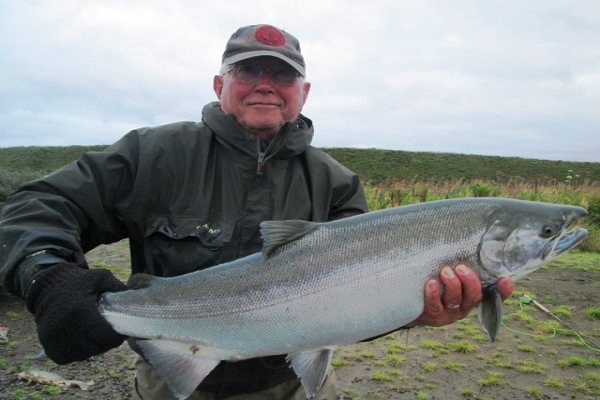
Picture this: Yours Truly hiding in the tall grass next to the bank, with the tip of my Spey rod sticking out over the water. I’m keeping the Pollo above the surface, with several feet of coiled line held in my hand, ready to drop it front of a coho when the opportunity presents itself. The group of bright silvers holding beneath the tree branches begins to bump each other, and a large buck with broad shoulders peels away from the bunched up fish, seemingly annoyed… he then re-positions himself a yard downstream of my rod, whereupon I release the fly, then gently wiggle it enticingly in front of him… his jaws yawn open as he swims forward to eat my pattern… I lift the rod, and the surprised fish shakes his head violently, then tears off across the swift current, while I arise with numb legs and attempt to clumsily follow…
Earlier in the week, as I stood in the shallows along a gravel bar near camp, I was pleasantly surprised to see the PPE Pollo disappear in a massive boil while it dangled a few yards beyond my Spey rod. Somehow — and in spite of being completely unprepared — I managed to remain attached to this 11-pound chrome-sided hen, gratefully landing her after a spirited battle replete with body twisting leaps and blasting runs. Closer inspection of this unlikely spot revealed a short and narrow slot with soft water and just enough depth for salmon to rest in, after negotiating the long, swift rapids below. I thenceforth made sure to swing my fly through this hidden lie every evening, which produced at least one jarring strike each time.
Quite a few of the fish I hooked in this particular spot elected to bid adios muy pronto by immediately blasting back down the long rapid that they had so strenuously negotiated. This created a curious mixture of exhilaration and despair as I tried to unsuccessfully slow the departing cohos with my palm held against the chattering Hardy reel (and getting my knuckles badly bruised instead). The backing melted away as the sprinting silvers emptied the spool, saluting me far downstream with their tails raised high (aka the piscine version of an outstretched middle finger). While I did manage to coax a number of these hooked fish back up to me by employing Trevor’s “Walk The Dog” technique, many of them gained their freedom after the hook pulled out (likely due to excessive pressure from fighting against heavy current).
My last two days on the Sapsuk passed in a blur of Spey casts, protesting reels, and acrobatic salmon dashing about. All seven of us ended up at the Weir Pool during the final afternoon, and we were constantly hooked up as yet more fresh, sea-lice adorned cohos continued to pour into the run. Diana fished off the stern of Mike’s parked boat, and caught fish after fish from this comfy casting platform without having to get her waders wet, while her husband Jerry spanked the silvers with his “Coho Death Star” fly/spinner combination. Mike and Mark also had their Spey rods constantly bent by grabby cohos that tore across the pool like wild demons. Meanwhile, our conga line of Kirk, Charlie, and moi fished the lower end, working downstream in unison, and our triple-headers were announced by gleeful shouts of “Fish On!” and “Coho!”. For three hours straight, I tried to make a swing without a grab, but failed to do so – there were so many eager biters. Nearly all of the fish were dime bright, and there were lots of double-digit sized silvers landed by everyone.
That evening, we took the opportunity to compliment our wonderful camp staff for all of their dedicated efforts during the week. I gave Kathy jars of homemade wild raspberry jam (which she was delighted to receive), and I augmented Trevor’s après-guiding beverage supplies (he was also pleased with the gifts of a hoodie and aluminum fishing pliers). We knew that our head guide Mike would turn 50 in a couple of weeks, and he had a broad grin as I presented him with a 9-weight Spey rod (a classic Sage “brownie”) for his birthday, which would be put to good use during next year’s chinook salmon season on the Sapsuk. Charlie added a beautiful filet knife (custom made by an Alaska craftsman), and all of us laughed at the pile of black balloons strewn about the floor of the dining tent, in honor of Mike’s half-century milestone.
During the angling session that last evening, my penultimate silver salmon turned out to be the largest, strongest, and fiercest fish of all the ones that I had caught this trip. The giant buck grabbed at the top of Silver Tree, where he smashed my PPE at the end of the swing mere feet from the bank. I was (fortunately) using the heaviest Spey rod in my arsenal – a Winston BIII 13.5’ 8-weight — which immediately doubled over from the vicious strike, and it throbbed as the angry fish strove in vain to shake the annoying hook from his jaws with shakes of his massive head. Failing to free himself, he then turned into the heavy current, and powered toward the far bank. The hair-raising run ended in a series of yard-high, aerial cartwheels followed by stupendous crashes back into the flows, before he bolted downriver in an unstoppable run. The Hardy screeched noisily as he tore off, causing the handle to spin wildly as the thin backing whipped through the rod guides. I could not follow the fish because it was too dangerous for me to wade beyond the outstretched alder branches; I would have been instantly swept off my feet into the swift current, and I thus had no choice but to hang on and hope that he wouldn’t spool me.
Senor Coho Grande finally stopped his mad headlong dash, and held amidst the boulders far below me. In response to my predicament, I directed a string of choice phrases at the fish, finally deciding that a Hail Mary maneuver was my only remaining option. I stripped a few yards of the severely depleted line and tossed it out with a flick of the rod tip. Although the current quickly pulled it tight again, I hoped that there had been sufficient time for the heavy Skagit head to belly below the fish and turn him back towards me. The fishing gods smiled upon me as my desperate tactic worked, and I felt an easing of tension as the mighty salmon powered steadily upstream. I lowered the Spey rod into the water, reeling slowly to take up the slack while not alarming him, and in such fashion, I managed to retrieve most of the running line — only to have the fish dash back downriver when he realized my feint. The chatter from the Hardy grew to a banshee howl as he blitzed towards the safety of the rapids below, while I could do naught but hang onto the bucking rod with grim determination.
I was about to concede defeat when, for some odd and still unknown reason, the big buck suddenly stopped at the very lip of the distant tail-out below. Scarcely daring to believe my luck at this unexpected reversal of fortune, I did my best to avoid pressuring him and provoking yet another frantic response. Hey, I’m The Coho Whisperer I said to myself as the salmon succumbed to the now-familiar “Walking the Dog” technique. Yards of Dacron backing, then the RIO ConnectCore running line followed by the AirFlo Skagit head, were slowly wound back onto the spool until I glimpsed his enormous form flashing in the depths only a rod length away.
As the huge coho held in the current, I looked around me and suddenly realized that options for landing him were extremely limited: I saw that there was only a small indentation on the high bank with a tiny, steeply sloping beach a few yards upstream where I could possibly corral this fish. Fearing yet another bolting run, I nevertheless pushed him as much as I dared, using a combination of heavy nylon leader, straining boron/graphite rod, and quivering hand locked onto the aluminum reel. Time and time again, I would pull him downstream and towards the bank into the miniscule cove – but as soon as his ponderous belly would touch the gravel, he’d flex his powerful body and swim triumphantly back out into the river. This cycle repeated itself at least a dozen times before his stubborn strength finally ebbed, and he surrendered as I held him submerged against the narrow ledge. I marveled at the shiny scales atop his thick flank winking in the setting sunlight, and watched the massive hooked jaw working tiredly to pump water through his crimson gills, as he gazed at me with an upturned, pearlescent eye. The wrist in front of his tail was so big that it took both of my hands to grip him, as I knelt and gently nudged the fish a bit further out of the water using my wader-clad legs. I managed to snap two photos before the stinger hook slid out of his jaw, whereupon he took advantage of his sudden freedom to re-right himself, then swim between my spread legs and completely soak me with an indignant departing splash from his broad tail.
The next morning, I finished packing my gear, then ate one last yummy breakfast before boarding the boats for the return trip back to the village. After bidding farewell to our camp crew, we spent a few delightful hours again at Sharon and Kenny’s home, then flew back to Anchorage via the swift Pilatus (stopping briefly in Dillingham to re-fuel). From my lofty vantage, I marveled at the vast waters of Illiamna Lake sparkling in the sun, and gazed longingly at Aniakchak volcano beneath the us, vowing to someday float through the gorge carved by the river exiting from its lake-filled crater. The broad sand flats filled with delicious razor clams on the west side of Cook Inlet beckoned to me, and I felt an urge to ask our pilot to set down next to one of those clear water systems flowing into the sea… surely, there must be anadromous chrome in them worthy of seeking with a Spey rod and swinging fly…
Copyright 2018 © GF Spey
Permission to use this article and/or photos can be obtained in writing from:
Glenn Chen, GF Spey
PO Box 2198, Homer AK 99603
homerpisces@yahoo.com
